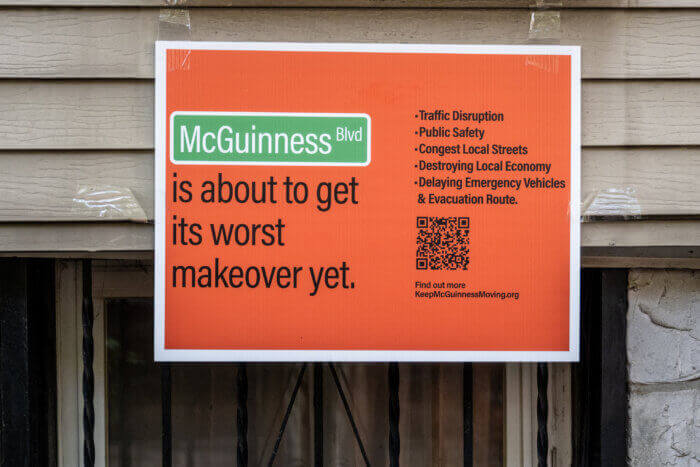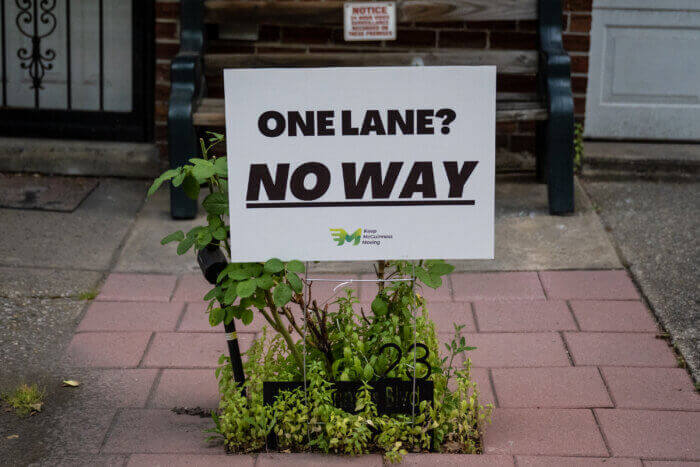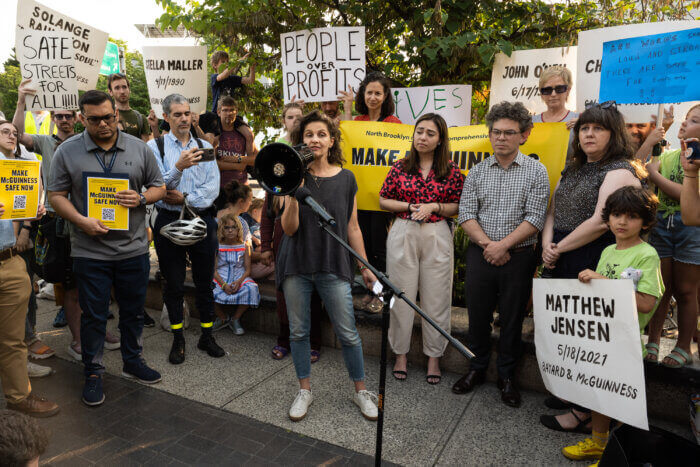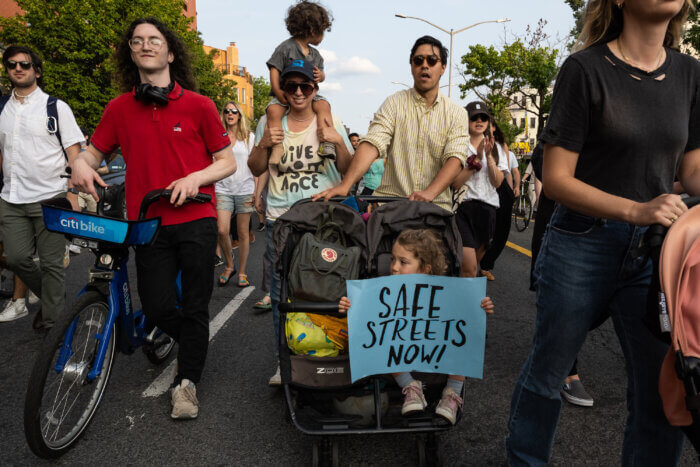DOT Plan for Greenpoint's McGuinness Boulevard Faces Opposition From Local Coalition
The future of the city’s proposed redesign of McGuinness Boulevard, which had seemed all but certain a few weeks ago, may be in question as opponents ask the Department of Transportation to reconsider its plans.

As opposition to the McGuinness Boulevard plan grew last week, supporters marched down the road, demanding the city stick with its promises. Photo by Gabriele Holtermann
The future of the city’s proposed redesign of McGuinness Boulevard, which had seemed all but certain a few weeks ago, may be in question as opponents ask the Department of Transportation to reconsider its plans.
A coalition of local businesses dubbed “Keep McGuinness Moving” is rallying against the planned road diet, claiming it will “destroy the local economy” by cutting down on the number of vehicle lanes on the boulevard, a designated truck route.
For years, locals have called on the city to redesign the notoriously dangerous four-lane roadway — and last month, after years of meetings, surveys, and workshops, DOT unveiled their final proposal.
The plan, designed to make the road safer for all users — pedestrians, cyclists, and motorists — removes one lane of vehicle traffic in each direction and adds a protected bike lane on each curb.

According to DOT data, 230 people were injured in crashes on McGuinness Boulevard between 2016 and 2020. Most — 176 — were drivers or passengers in vehicles.
The proposal was lauded by groups like Make McGuinness Safe and local elected officials, though some neighbors remained skeptical, and DOT said it would start work this summer.
Weeks later, Keep McGuinness Moving ramped up its opposition — calling the proposed redesign McGuinness Boulevard’s “worst makeover yet.” According to its website, the coalition had the support of nearly 200 local businesses.
Opposition to the McGuinness Boulevard redesign
Keep McGuinness Moving held a town hall meeting with DOT representatives and elected officials on June 15.
According to news outlet THE CITY, at least 51 of the businesses listed on the group’s site are linked to Gina and Tony Argento, the owners of local film and production company Broadway Stages. The list was removed from the website “due to harassment and unanimous concern for safety” after THE CITY’s story was released.
In a June 12 statement issued by Broadway Stages, Gina Argento, the company’s president and CEO, said in a June 12 statement the proposed road diet would have “harmful effects on both businesses and residents.”
“It is critical that additional traffic research studies and analysis be made to determine the best solution for all of Brooklyn,” she said. “The old bureaucracy left our community with all of these issues to fix and now it’s up to us, the community and our new administration, to work together to fix it.”
The statement outlined the company — and the coalition’s — major concerns: that the road diet would increase traffic, preventing trucks from delivering to local businesses and impeding an evacuation route and pushing vehicles onto neighboring residential streets.
When DOT introduced its plan at a May 4 meeting of Brooklyn Community Board 1, it addressed several of those concerns. McGuinness Boulevard is no longer used as a designated evacuation route, explained agency engineer Zachary Wyche.

The department does expect to see an increase in traffic during a transition period immediately after the road diet is implemented — but expects conditions to ease as drivers choose alternative routes.
More than 30% of drivers on McGuinness Boulevard on a given weekday are using the street as a cut-through to avoid the Brooklyn-Queens Expressway and the Long Island Expressway, according to DOT data, and many of those drivers would likely choose to stay on the highway rather than exiting onto McGuinness Boulevard.
“Right now, McGuinness Boulevard prioritizes one group and one group alone, and that’s car owners and car drivers,” said Kevin LaCherra, a longtime Greenpointer and member of Make McGuinness Safe. “Primarily, it prioritizes cut-through commuter traffic. McGuinness Boulevard is not built to prioritize local people.”
The June 15 town hall was originally scheduled to occur on May 25 — but was rescheduled, with organizers citing scheduling complaints with Council Member Lincoln Restler and Assembly Member Emily Gallagher.
A representative for Gallagher, however, said the representative had never been invited to the first meeting — so her schedule was not the cause of the cancellation.
She was also not asked to attend the June 15 town hall, the rep said, and opted to send a staff member instead.

The meeting was otherwise well attended, both by supporters of Keep McGuinness Moving and by opponents. Ahead of the event’s 9 a.m. start time, protestors lined up with signs bearing the names of those killed on McGuinness Boulevard.
Attendees said the meeting began at around 8:20 a.m., well ahead of its planned start — and that Broadway Stages refused to let protestors and other would-be attendees in, even though they had registered ahead of time.
“It was supposed to be a public meeting,” said Broadway Stages spox Jude Engelmayer, but there were concerns regarding occupancy limits and fire department regulations. “I don’t know that anyone from our side was blocking the door.”
Inside, Tony Argento was reportedly discussing the importance of safety — while local business owners said they worried about the impact new bike lanes would have on their shops and industrial businesses.
Nicole Fell, a 25-year resident of Greenpoint and Williamsburg who recently moved to Bushwick, said she bikes through the neighborhood to get to her ceramics studio in Long Island City every day. The longtime cyclist said she’s for pedestrian safety improvements, but doesn’t agree with the installation of bike lanes on McGuinness Boulevard.
“As a cyclist, it makes no sense to be on McGuinness Boulevard,” she said, adding that there are a number of bike lanes on adjacent streets.
Fell heard about the Keep McGuinness Moving meeting last week and attended because she wanted to speak out against the current proposal. Rather than taking away a vehicle traffic lane on McGuinness Boulevard, she suggested building new dedicated bike lanes nearby and adding signage to existing bike routes at the Pulaski Bridge to direct cyclists down safe streets.
“I agree that it needs to be looked at and made more safe for crossing pedestrian traffic and for bikers,” she said. “I do not think the way in which they’re going about it makes any sense to make that happen.”
Engelmayer, on behalf of Broadway Stages, said the Keep McGuinness Moving campaign is looking for alternate designs without bike lanes on McGuinness. Restricting truck traffic could dry up local businesses, he said, affecting the lives of not only business owners, but their employees and the local economy, too.
“We shouldn’t just yield to people because they want to go on the truck lane on their bicycle,” he said. “If we want to have a cooperative environment, where everyone is compromising, where everyone is getting a little bit of what they do want and a little bit of what they don’t want.”
‘Taking safety one step further’
Hours after the Keep McGuinness Moving rally, hundreds of people gathered with Make McGuinness Safe to rally in support of the redesign.
They met at the corner of McGuinness Boulevard and Bayard Street, where P.S. 110 teacher Matthew Jensen was killed in a hit-and-run in 2021.
Greenpointer Bronwyn Breitner helped to create Make McGuinness Safe after Jensen — her child’s teacher — was killed. She and other activists were “thrilled” when DOT unveiled their final proposal last month.
“I think it represents a really safe street, it represents the undoing of this massive divide in the neighborhood that never should have happened to begin with,” she said.
Keep McGuinness Moving has been a presence in the nabe for about a year and a half, Breitner said, and has repeatedly misrepresented the mission of Make McGuinness Safe and the facts about the redesign.
The accusations from detractors that the plan wasn’t discussed publicly or shared with the neighborhood are “so absolutely untrue,” she said.
The DOT has visited Brooklyn Community Board 1 — where Gina Argento sits on the Transportation Committee — several times over the last few years, and has held workshops and canvasses both in-person and online.

“We’re taking safety one step forward with a redesign proposal that narrows the roadway to ensure safer pedestrian crossings and safer truck turns; adds protected bike lanes along both curbs; creates neighborhood loading zones on each block; shortens crossing distances, and discourages cut-through traffic,” said DOT spox Vin Barone. “We’ve conducted extensive outreach through dozens of meetings over multiple years on this project, and we continue to review community stakeholder feedback as we finalize the design.”
Studies show road diets typically don’t make traffic worse — and make busy New York City roads safer for all users. DOT is still on track to begin implementing the redesign this year.
The city has made a number of small changes to McGuinness Boulevard over the years, LaCherra said, but all those small changes haven’t stopped the deaths, or the injuries.
“That’s why we’re doing this work, because someone was killed,” he said. “And without a comprehensive intervention, it’s going to happen again. And then where will we be?”
Breitner said she understands the fear people feel regarding the redesign and change in the neighborhood — especially if they are worried about the future of their business, given the messages that have been circulating in recent weeks.
“We need to rely on our professionals, we need to rely on those precedents, the history, and look at plans that have been implemented in the past and worked or not worked,” she said. “We need to be able to look at those patterns and learn from them. And we need to be able to use data and science and facts to plan and make changes that will positively impact our neighborhood.”
[Photos by Gabriele Holtermann]
Editor’s note: A version of this story originally ran in Brooklyn Paper. Click here to see the original story.
Related Stories
- DOT Plan for Problem-Plagued McGuinness Boulevard Includes New Bike Lanes
- Locals Demand Dramatic Redesign of Greenpoint’s McGuinness Boulevard Ahead of DOT Reveal
- Ped Critically Injured on Problem-Plagued Stretch of McGuinness in Greenpoint Due for Redesign
Email tips@brownstoner.com with further comments, questions or tips. Follow Brownstoner on Twitter and Instagram, and like us on Facebook.









What's Your Take? Leave a Comment